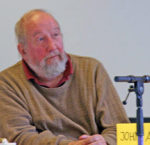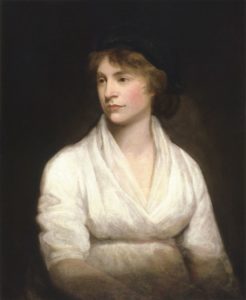We Need Their Voices Today! (5) Mary Wollstonecraft
TRANSCEND MEMBERS, 24 Jul 2017
John Scales Avery, Ph.D. – TRANSCEND Media Service
Introduction
This is a collection of biographical sketches showing people whose wise voices from the past can help to guide us today. All of the women and men, brief glimpses of whose lives and ideas are portrayed here, gave a high place to compassion. None of them was a slave to greed. We need their voices today!
[Note from TMS editor: It will be posted one biographical sketch per week]
**********************************************
The First of a New Genus
Mary Wollstonecraft was born in London 1n 1759. Although her family had a comfortable income during her childhood, Mary’s father later lost his fortune through speculation, and the family entered a period of severe financial difficulties. He also subjected his wife to physical violence, and Mary often slept in front of her mother’s door in order to protect her.
Because of the family’s financial problems, Mary was forced to take a number of jobs which she found very distasteful, for example as companion to an unpleasant old lady. However, while working, she tried her hand as a writer, producing a children’s book, “Original Stories From Real Life” (1788), and two pioneering feminist books, “Thoughts on the Education of Daughters” and “Mary: A Fiction” (1788).
Mary Wollstonecraft then bravely decided to try to support herself through writing. As she wrote to her sister, had decided to become the first of a new genus: a professional female writer. Having learned French and German, she translated Necker’s “Of the Importance of Religious Opinions” and Saltzman’s
“Elements of Morality for the Use of Children”. Mary was helped in her new career by the liberal publisher, Joseph Johnson, who was also the publisher of Thomas Paine and William Godwin. Mary met these already famous authors at Johnson’s dinner parties, and conversations with them helped to expand her knowledge and ambitions. Joseph Johnson was a very brave man. By publishing the works of radical authors, he was risking arrest by England’s repressive government. In her letters, Mary described Johnson as “a father and brother”.
Scandalous Love Affairs
Mary Wollstonecraft had two scandalous love affairs. At that time, according to the strict rules for female behavior, these placed her completely outside the bounds of society.
The first of these unconventional love affairs was with the already married artist Henry Fuseli. Mary proposed to Fuseli’s wife that all three of them should live together, but (not surprisingly) Fuseli’s wife rejected this plan in horror and forced her husband to break off the relationship with Mary.
Mary then decided to travel to France, where the French Revolution had just taken place. She arrived there in 1792, about a month before the execution of Louis XVI. There she fell passionately in love with an American adventurer, Gilbert Imlay, with whom she had a daughter named Fanny. When Britain declared war on France in 1794, Imlay registered Mary as his wife in order to protect her from the French authorities, even though they were not married.
Vindication of the Rights of Women
While in France, Mary Wollstonecraft had written “An Historical and Moral View of the French Revolution”, which was published in London in 1794. She also wrote “Vindication of the Rights of Woman” (1792) and “Vindication of the Rights of Man” (1792). Both of these were replies to Edmund Burke’s argument for conservatism, “Reflection on the Revolution in France”.
In her book on the rights of women, Mary wrote: “My main argument is built on this simple principle, that if [woman] be not prepared by education to become the companion of man, she will stop the progress of knowledge and virtue; for truth must be common to all”.
Wollstonecraft contends that society will degenerate without educated women, particularly because mothers are the primary educators of young children. She attributes the problem of uneducated women to men and to “…a false system of education, gathered from the books written on this subject by men who [consider] females rather as women than human creatures.”
“Taught from their infancy that beauty is woman’s sceptre, the mind shapes itself to the body, and, roaming round its gilt cage, only seeks to adorn its prison.
“I then would fain convince reasonable men of the importance of some of my remarks; and prevail on them to weigh dispassionately the whole tenor of my observations. I appeal to their understandings; and, as a fellow-creature, claim, in the name of my sex, some interest in their hearts. I entreat them to assist to emancipate their companion, to make her a help meet for them! Would men but generously snap our chains, and be content with rational fellowship instead of slavish obedience, they would find us more observant daughters, more affectionate sisters, more faithful wives, more reasonable mothers: in a word, better citizens.”
Return to England and Marriage to William Godwin
When France became too dangerous, Imlay had traveled to London, and Mary joined him there in 1794, hoping to continue their relationship. When he rejected her, she attempted suicide. In another attempt to win Imlay’s affections. Mary traveled to Norway to take care of Imlay’s business dealings there. But when she returned to London, Imlay once again rejected her, and she once again attempted suicide. Once again was saved, this time by someone who saw her leap from a bridge into the Thames.
Gradually recognizing that her pursuit of Imlay was hopeless, Mary resumed her writing career, encouraged, as before by by the brave publisher Joseph Johnson. At Johnson’s parties she once again met the famous novelist and philosopher William Godwin. This time, they both formed a higher opinion of each other than at their first meeting. A passionate love affair developed between them, and when Mary became pregnant, they were married. Tragically, Mary Wollstonecraft died in childbirth. Her daughter with William Godwin would later become the wife of Godwin’s admirer, the poet Percy Bysshe Shelley. Mary Shelley continued the family tradition by becoming a famous author: She created the masterpiece “Frankenstein”.
Mary Wollstonecraft, pioneering advocate of the rights of women and all human rights, we need your voice today!
Contents:
1 Saint Francis of Assisi
2 William Blake
3 Thomas Paine
4 Thomas Jefferson
5 Mary Wollstonecraft
6 William Godwin
7 The Marquis de Condorcet
8 Thomas Robert Malthus
9 Percy Bysshe Shelley
10 Robert Owen
11 John Stuart Mill
12 Henry David Thoreau
13 Count Leo Tolstoy
14 Mahatma Gandhi
15 Martin Luther King
16 Wilfred Owen
17 Albert Einstein
18 Edna St. Vincent Millay
19 Bertha von Suttner
20 George Orwell
21 Helen Keller
22 We need their voices, and yours!
________________________________________________
 John Scales Avery, Ph.D., who was part of a group that shared the 1995 Nobel Peace Prize for their work in organizing the Pugwash Conferences on Science and World Affairs, is a member of the TRANSCEND Network and Associate Professor Emeritus at the H.C. Ørsted Institute, University of Copenhagen, Denmark. He is chairman of both the Danish National Pugwash Group and the Danish Peace Academy and received his training in theoretical physics and theoretical chemistry at M.I.T., the University of Chicago and the University of London. He is the author of numerous books and articles both on scientific topics and on broader social questions. His most recent books are Information Theory and Evolution and Civilization’s Crisis in the 21st Century (pdf).
John Scales Avery, Ph.D., who was part of a group that shared the 1995 Nobel Peace Prize for their work in organizing the Pugwash Conferences on Science and World Affairs, is a member of the TRANSCEND Network and Associate Professor Emeritus at the H.C. Ørsted Institute, University of Copenhagen, Denmark. He is chairman of both the Danish National Pugwash Group and the Danish Peace Academy and received his training in theoretical physics and theoretical chemistry at M.I.T., the University of Chicago and the University of London. He is the author of numerous books and articles both on scientific topics and on broader social questions. His most recent books are Information Theory and Evolution and Civilization’s Crisis in the 21st Century (pdf).
This article originally appeared on Transcend Media Service (TMS) on 24 Jul 2017.
Anticopyright: Editorials and articles originated on TMS may be freely reprinted, disseminated, translated and used as background material, provided an acknowledgement and link to the source, TMS: We Need Their Voices Today! (5) Mary Wollstonecraft, is included. Thank you.
If you enjoyed this article, please donate to TMS to join the growing list of TMS Supporters.

This work is licensed under a CC BY-NC 4.0 License.

